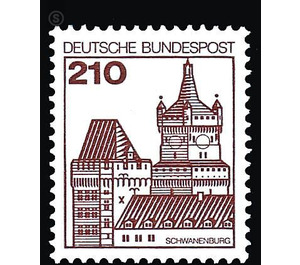Postage stamp: castles and palaces - Germany / Federal Republic of Germany 1979 - 210 Pfennig
Theme: Architecture
| Country | Germany / Federal Republic of Germany |
| Issue Date | 1979 |
| Face Value | 210.00 |
| Color | brown |
| Perforation | K 14 |
| Printing Type | Lithography |
| Stamp Type | Postage stamp |
| Item Type | Stamp |
| Chronological Issue Number | 885 |
| Chronological Chapter | GER-BRD |
| SID | 902244 |
| In 50 Wishlists | |
Supplementary values to the 1976/77 series of roller stamps permanent series »Castles and Palaces« The 20 Pf value appears with the inscription Deutsche Bundespost; With the inscription Deutsche Bundespost Berlin, this value has already been issued on April 14, 1977. The value of 210 Pf appears simultaneously and identically with the inscription Deutsche Bundespost Berlin. The Schwanenburg in Kleve, an impressive assembly, represented in the 17th and 18th centuries by numerous Dutch painters, rises above Kleve on a hill (Clive = cliff). This was probably already fastened in the late Carolingian period and then gave the name of the known Graf family. A legend derives its origin from the "Swan Knight": A Herr von Kleve left a beautiful daughter, who had been besieged by willing to marry. Then she saw a swan pulling a boat, and in it a stately man, coming from the Grail. He married her and had 3 children with her. She had asked him contrary to his instructions for his origin, whereupon he had disappeared. A carbuncle in the coat of arms is to attest to the derivation of the Swan Knight. The legend comes from Brabant and probably came through family relations to Kleve. The family lived in the castle since about the middle of the 11th century. After its extinction, the area fell in 1368 to the Counts of the Mark (since 1417 dukes). Duke Adolf (1394-1448) made the romantic arrangement late gothic: new construction of the Spiegelturm (finished in 1429), Johann Wyrenbergh gave the Schwanenturm its memorable form (1453 finished). In 1444 the chapel collapsed, in 1456 and 1462 it was re-arched. Under William the Rich (1539-1592) Maximilian Pasqualini added since 1560 the farmyard (1816 canceled). In 1614 Kleve fell to Brandenburg. From 1663 to 1666 Elector Friedrich Wilhelm had the castle rebuilt by Pieter Post. The gap between the Schwanenturm and Spiegelturm was closed and a new transverse wing was erected between the outer bailey and the main castle. The courtyards were surrounded by arcades. Since 1771 demolitions occurred, since 1828, the Prussian administration of justice carried out conversions. In 1944/45 the castle suffered severe damage (eliminated until 1955). Now it serves as a district court and holds a geological collection worth seeing. (Extract from texts by the German Castle Association e.V. Braubach - Dr. W. Avenarius)


